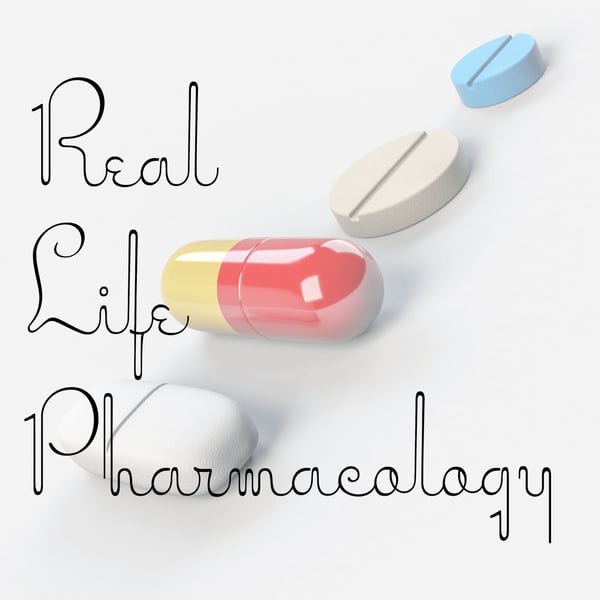Hydrochlorothiazide Pharmacology
Real Life Pharmacology - Pharmacology Education for Health Care Professionals
Eric Christianson, PharmD; Pharmacology Expert and Clinical Pharmacist
5 • 716 Ratings
🗓️ 22 July 2021
⏱️ 13 minutes
🧾️ Download transcript
Summary
Hydrochlorothiazide has common brand names of Microzide, Hydrodiuril, and its common abbreviation is HCTZ. Extra caution should be taken with “HCTZ”; it may be mistaken for other abbreviations. Hydrochlorothiazide works pharmacologically by blocking the reabsorption of sodium in the distal tubule of the kidney. The result of the pharmacology of hydrochlorothiazide is increased water, sodium, and potassium excretion. Due to hydrochlorothiazide’s mechanism of action, it makes it advantageous when used for blood pressure, edema, and heart failure in addition to loop diuretics.
Hydrochlorothiazide’s adverse reactions are due to its pharmacology. Frequent urination should occur so, dosing hydrochlorothiazide at night should be avoided. Loss of electrolytes should also happen, and the risk for hypokalemia, hyponatremia, and hypomagnesemia increases. Other adverse reactions include the increased risk of dehydration, increased uric acid concentrations, and hypercalcemia. The risk for hypercalcemia is not as concerning in lower doses. There is a potential for a sulfonamide allergy. If the patient has had an anaphylactic reaction with a sulfonamide-containing medication, hydrochlorothiazide may want to be avoided, or at least a risk/benefit assessment should be done. Another potential adverse reaction is an increase in blood sugar, but that is not typically concerning at lower doses. Electrolytes, as well as creatinine clearance, should be monitored to make sure kidney function, and electrolyte levels remain stable.
Drug-drug interactions that can occur with hydrochlorothiazide are additive effects that may happen when taken with other medications. The risk for an unsafe drop in blood pressure may increase if it is taken with PDE inhibitors, Sinemet, or SGLT2 inhibitors. Hydrochlorothiazide should be avoided with Lithium, the risk for toxicity increases when the two are taken concurrently due to Lithium concentrations being increased. The risk of an AKI increases if it’s taken with NSAIDs, ACE inhibitors, or ARBs; increased monitoring is warranted. Topiramate may increase the risk for hypokalemia, while vitamin D and calcium supplements may increase the risk for hypercalcemia. Hyponatremia may be more likely to occur if it’s taken with SSRIs, carbamazepine, or oxcarbazepine. Hydrochlorothiazide may blunt the effect of allopurinol if it’s used for gout. Since blood sugar levels may be increased, hyperglycemia can occur, but it’s typically not clinically significant.
In cases of intolerability, or overdoses, the manifestations are extensions of hydrochlorothiazide’s adverse effect profile. Most commonly, electrolyte depletion and dehydration will occur.
Transcript
Click on a timestamp to play from that location
| 0:00.0 | Hey, all, welcome back to the Real Life Pharmacology podcast. I'm your host, pharmacist, Eric Christensen, |
| 0:05.7 | and I thank you so much for listening. As always, go check out real-life pharmacology.com. |
| 0:11.5 | Go check out our free 31-page PDF on the top 200 drugs. |
| 0:17.0 | A great little resource if you're preparing for, you know, some sort of of board exam or if you just want a refresher. |
| 0:22.2 | If you've been in clinical practice for a while and want an update on the top 200 drugs and kind of their common clinical quirks and pearls, definitely go check that out at real life pharmacology.com. |
| 0:34.8 | Absolutely free to you simply for subscribing. All right, so let's get into the drug of |
| 0:40.8 | the day today, and that is hydrochlorothiozyde. So this medication is classified as a thiozyde diuretic. If you've spent |
| 0:51.9 | any time in medicine working with patients, you've likely seen it. |
| 0:58.0 | I will say it's probably fallen a little more out of favor over time here. |
| 1:03.1 | But certainly with all the combinations of blood pressure medications, |
| 1:08.5 | you still see hydrochlorothyside quite a bit. So by itself, |
| 1:13.4 | brand name is microzyde hydrodiural. Can't say I see those very often. Most often, what you're |
| 1:22.6 | going to see in clinical practice is HCTZ and abbreviation, which, you know, ISMP and, you know, for risk of medication |
| 1:32.1 | errors and things like that. We are supposed to kind of go away from abbreviations. However, |
| 1:38.6 | it is real life and you certainly do see it. I have seen errors result or errors be reported from using the abbreviation H-C-T. |
| 1:50.7 | That could be confused with something like hydrochortosone, for example. |
| 1:55.5 | So again, be really, really careful with those abbreviations, |
| 1:58.9 | but H-C-T-Z has typically been pretty standard for hydrochlorothiozyde. |
| 2:05.4 | Uses, blood pressure, probably being the number one use there. |
| 2:09.8 | I have seen it occasionally used for some milder edema and potentially even added on in heart failure situations on top of a loop diuretic. |
| 2:23.5 | More often I see metolazone, but again, very rare cases I have seen it, |
| 2:29.2 | but again, you're going to see it more often for blood pressure. |
... |
Please login to see the full transcript.
Disclaimer: The podcast and artwork embedded on this page are from Eric Christianson, PharmD; Pharmacology Expert and Clinical Pharmacist, and are the property of its owner and not affiliated with or endorsed by Tapesearch.
Generated transcripts are the property of Eric Christianson, PharmD; Pharmacology Expert and Clinical Pharmacist and are distributed freely under the Fair Use doctrine. Transcripts generated by Tapesearch are not guaranteed to be accurate.
Copyright © Tapesearch 2025.

